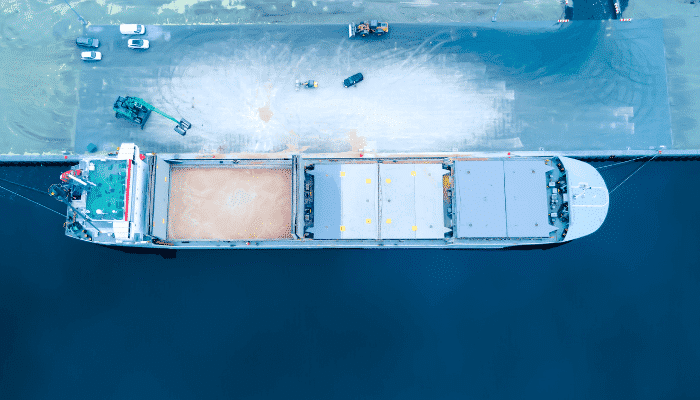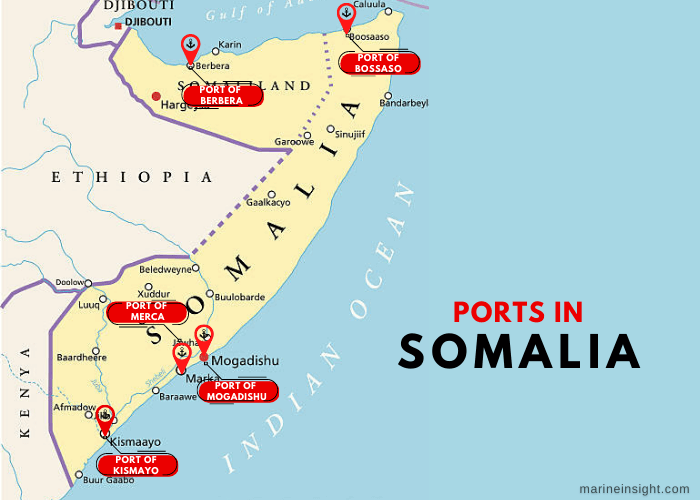5 Major Ports of Somalia
Lying on the eastern end of mainland Africa, the Republic of Somalia has been classified as a low-income country by the World Bank with an annual GDP of about $5.42 billion in 2021. However, it is witnessing gradual economic growth due to increased foreign investment in the country’s industrial and telecommunications sectors.
Agriculture is the mainstay of the Somali economy, employing more than half of the population. Possessing the largest camel population in the world, Somalia also has a thriving livestock sector which contributes around 55% to the annual export earnings.
Due to its proximity to the Arabian Peninsula, the Somali businesses have challenged Australia’s dominance over the region’s meat and livestock market. Thus, many Gulf countries have made heavy investments in Somalia and UAE has bought farmlands in the country.
Somalia is also a major producer of frankincense and myrrh; bananas, fish, animal hides, scrap metal and charcoal are other major export commodities.
Industries were badly affected by the civil unrest of the 1990s. However, today, local investments and government initiatives have led to the establishment of numerous manufacturing plants, and small-scale factories such as fish canning, meat and stone processing. The Mogadishu industrial region houses 30 factories making pasta, confectionaries, plastic bags, fabrics, detergent and soap, aluminium, foam mattresses and pillows, fishing boats etc.
Somalia has a diverse topography consisting of plateaus, plains and highlands. It has significant reserves of natural resources such as uranium, iron ores, tin, gypsum, bauxite, copper, salt and natural gas. However, the lack of infrastructure has not allowed the country to extract and utilise these resources to the fullest.
It has a 3333 km long coastline comprising the Gulf of Aden in the north, the Guardafui channel to the northeast and the Indian Ocean in the east.
Possessing the longest coastline in mainland Africa, Somalia houses numerous marine terminals and about 5 international port facilities.
Let us have a look at the major ports of Somalia.
1. Port of Mogadishu
Mogadishu Port is situated on the southeastern coast of Somalia, in the capital city and a few nautical miles from the strategic port of Mombasa. It is the principal port of Somalia, surrounded by a huge artificial breakwater stretching 359 m and a 14 m deep navigation channel. Classified as a major seaport, Mogadishu possesses the largest harbour in the country.
The port dates back to Roman times when it was known as a flourishing commercial centre of Sarapion. It declined during the middle ages and was revived with the arrival of the Italian sailors in the late 18th century who made drastic improvements and laid the foundations of a modern port facility.
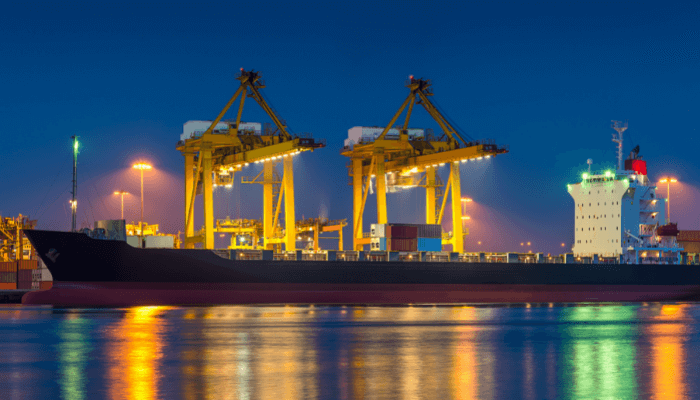
In the mid-1930s a protective dike with breakwaters was constructed at the facility and linked to the interior of Somalia through railways and a new imperial road going from Mogadishu to Addis Ababa. Since then, it has grown rapidly and emerged as one of the biggest ports in eastern Africa.
Presently, Mogadishu has 6 wharves including 5 general cargo berths measuring 160 m each, and a container berth with a quay length of 200 m. The port was modernised and re-opened in 2006 and can accommodate vessels weighing up to 10,000 DWT with a maximum draft of 9 m. Around 245 cargo laden ships visit the port annually. All types of cargo such as dry cargo, liquid bulk, containers, roro and breakbulk are handled at this facility, operated by the Mogadishu Alport Corporation, part of the Istanbul-based Albayrak Group.
The Container terminal
Around 80% of the cargo received at the Mogadishu International Port comprises containers followed by breakbulk such as cement, sand, and fuel. Hence, the container terminal offers container stuffing and de-stuffing services and has numerous open container yards for keeping full and empty containers. Around 12 to 15 container vessels are unloaded at the terminal every month.
Mogadishu port has a 303.000 sq m of yard area and a dedicated container freight station. It also has an import yard space divided into four stacking spaces and 3 empty container areas used by different shipping lines such as MSC, CMA-CGM etc.
The port also has three warehouses covering 5000 sq m each and a reefer yard with 40 connections, 3 port workshops offering minor repair works, a 20,000 m2 parking area and 4 terminal offices situated near the general cargo berths. This facility also has a RORO pier and a port control system. Port equipment is in working condition and includes 9 mobile cranes with a lifting capacity of 15 to 25 tonnes, 7 dockside cranes, 4 RORO tug masters with trailers and 3 forklifts capable of lifting 15 tonnes each.
2. Port of Berbera
Berbera port is located on the northern coast of Somalia, on the southeastern end of the Gulf of Aden. It is formed by a low lying sandy spit in the north which acts as a breakwater for the quays located in the south. The entrance channel is 800 m wide and around 16.5 m deep providing two anchorages. It is known for exporting animal hides, ghee, gum and livestock including sheep and goats. Major import commodities comprise cotton products, sugar, rice and dates. Approximately 250,000 tonnes of cargo and more than 130 vessels are handled at the Berbera port every year.
It was established more than a hundred years ago and served as a naval base for the Somali government in the 1990s. Following an agreement between the Somali authorities and the erstwhile Soviet Union in 1962, the port’s expansion was financed by the latter. A 350 m linear wharf was built in 1984 by the United States of America when the Somali government strengthened trade ties with the US. Since then, the port has grown manifold and contributed to the economic upliftment of the Somali land community.
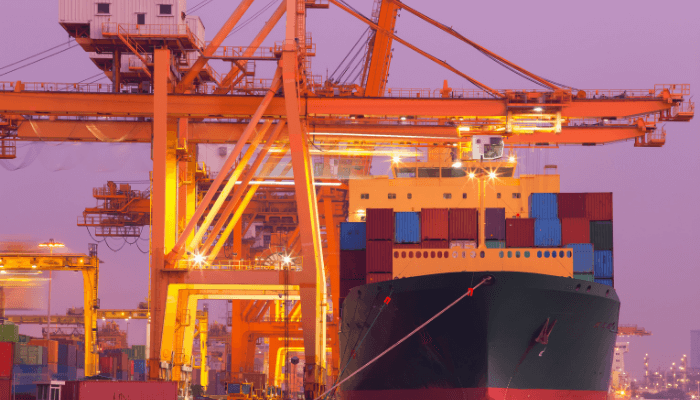
Berbera port has 5 conventional berths each measuring 125 m with an alongside depth of 7.3 m. It also has an additional RORO berth covering 100 m with a water depth of 9 m. Capable of accommodating ships with an LOA of 200 m, these facilities mainly receive livestock carriers and huge humanitarian aid cargoes.
New and modern port equipment was obtained in 2014. Berbera port has 10 mobile cranes with a 70-tonne lifting capacity, 2 forklifts, 3 reach stackers and 5 port trucks. Ample storage space is available including a 5760 m2 warehouse area for keeping 120,000 tonnes of cargoes and paved yards spanning 64,000 m2. A separate jetty receives oil from the tankers and is directly connected to the petroleum depot through a network of pipelines.
Container terminal
The container terminal is a new facility that became operational in June 2021, inaugurated by DP World and the Somali government. The terminal is being developed in phases and after the completion of the first phase, it has an annual container handling capacity of 500,000 TEUs which would rise to 2 million TEUs after the second phase is completed.
This container terminal has a draft of 17 m, a 400 m long quay, a modern container yard and eight rubber-tyred gantries and three ship-to-shore gantry cranes, capable of handling the biggest container vessels. A One-Stop service centre is also being constructed.
Financed by DP World, this port development project aims to transform Berbera into a major maritime trade hub of the region and a crucial logistics provider. A Free Economic Zone is also being developed to attract private investments and create employment opportunities.
3. Port of Bossaso
Also known as Bender Qaasim port, Bossasso is situated in the southern part of the Gulf of Aden. The harbour is protected by a 420 m mole in the north and a 200 m long breakwater in the south. It is a major seaport serving the Puntland region in northeastern Somalia. Main exports include livestock such as cattle, sheep, and camels. It also receives bulk shipments comprising cement, sugar, rice and construction material.
Bosaso port was primarily built for transporting livestock to the Middle Eastern nations, particularly UAE and Saudi Arabia. The work began in the mid- 1990s and culminated with the installation of modern facilities and equipment in 2012. During these years, civil war and political unrest had arrested the port expansion project. However, in the early 2000s, the port was cleaned up and unwanted debris was removed from the dockyards. In the second phase, it was dredged and additional berths were built to accommodate larger ships.
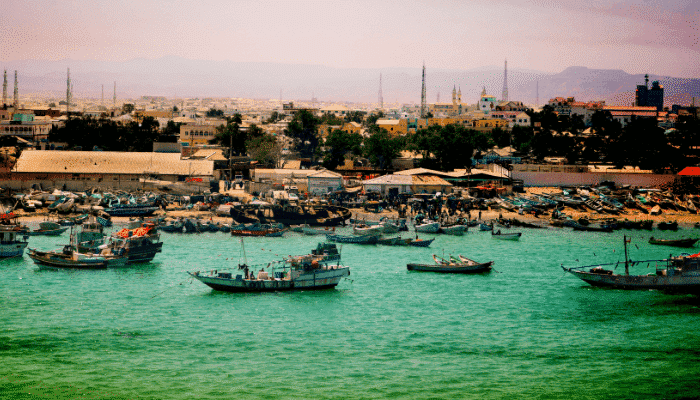
In 2017, P & O Ports, owned by DP World was given a 30-year concession for managing the Bosaaso port and for expanding it further. Hence, work began in 2017 for building a 455 m long quay and a 5.5 hectares storage area. It was further dredged to a depth of 12 m and the company also invested in the installation of the latest IT terminal operating system, and port equipment.
Livestock has been central to the growth and sustenance of the Bosaso port. Its development into a major livestock hub has helped the local pastoral communities and has boosted the economy of Puntland. A major gateway to Yemen, Bosaso has enormous scope for diversifying its services.
4. Port of Merca
The Port of Merca is situated in southern Somalia, on the Indian Ocean, just 70 kilometres southwest of the country’s major port of Mogadishu. It consists of an open roadstead and offshore coral reefs, making it mandatory to transport goods by lighters.
It is a jetty class port and is known for the export of Bananas. In the early 1900s, it was a small fishing village but was rebuilt into a real functional port by the town’s Italian governor who named it Porto di Merca. With the coming up of an Italian settlement in the port city, its infrastructure was improved and it was nicknamed ‘Porto bananiero’ or the port of bananas as even during this period, Bananas from Somalia were exported to almost all European countries.
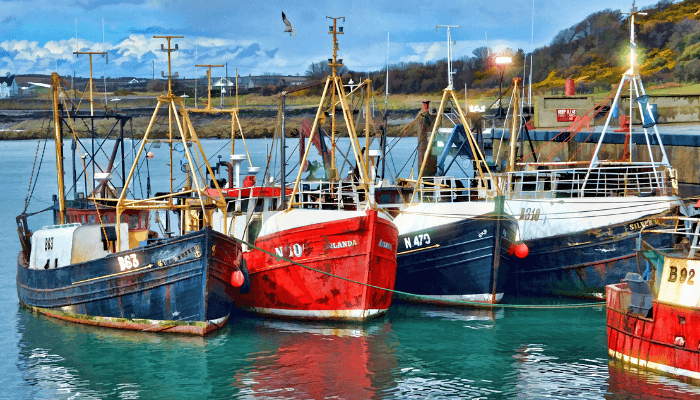
The port city witnessed economic growth in the mid-1980s due to growing commerce, construction of railways and increased agricultural production. However, it was destroyed during the civil war and port infrastructure was burnt. Since then, the port has not seen major expansion works and has been abandoned by the authorities. Only small fishing vessels and local fishermen can be seen in the rudimentary facility.
5. Port of Kismayo
Kismayo port is located on the southern coast of Somalia. It is formed by a sheltered bay and a southern concrete breakwater which provinces berthing facilities. It is used for exporting bananas and is visited by over 50 small ships and barges annually.
It was built in 1966 for shipping agricultural produce and light machinery since the road between Mogadishu and Kismayo was not accessible during monsoon months. Hence, it serves the region of lower Jubba but is in dire need of maintenance since 80% of port facilities are not operational. It receives humanitarian cargo vessels and a few containers shipped by the Mediterranean Shipping Company. Sugar is imported twice a month by the Hormuud Business Company.
Kismayo port lacks sufficient handling equipment and has only four warehouses, the biggest can store up to 1400 tonnes. No cold storage facilities are available at this port.
You might also like to read:
- 8 Major Ports in Australia
- 7 Major Ports in Kazakhstan
- 5 Major Ports in Mozambique
- 7 Major Ports in Sweden
- 6 Major Ports in Argentina
Disclaimer: The authors’ views expressed in this article do not necessarily reflect the views of Marine Insight. Data and charts, if used, in the article have been sourced from available information and have not been authenticated by any statutory authority. The author and Marine Insight do not claim it to be accurate nor accept any responsibility for the same. The views constitute only the opinions and do not constitute any guidelines or recommendations on any course of action to be followed by the reader.
Do you have info to share with us ? Suggest a correction

About Author
Shilavadra Bhattacharjee is a shipbroker with a background in commercial operations after having sailed onboard as a Third Officer. His interests primarily lie in the energy sector, books and travelling.
Latest Maritime Knowledge Articles You Would Like:
Subscribe To Our Newsletters
By subscribing, you agree to our Privacy Policy and may receive occasional deal communications; you can unsubscribe anytime.



